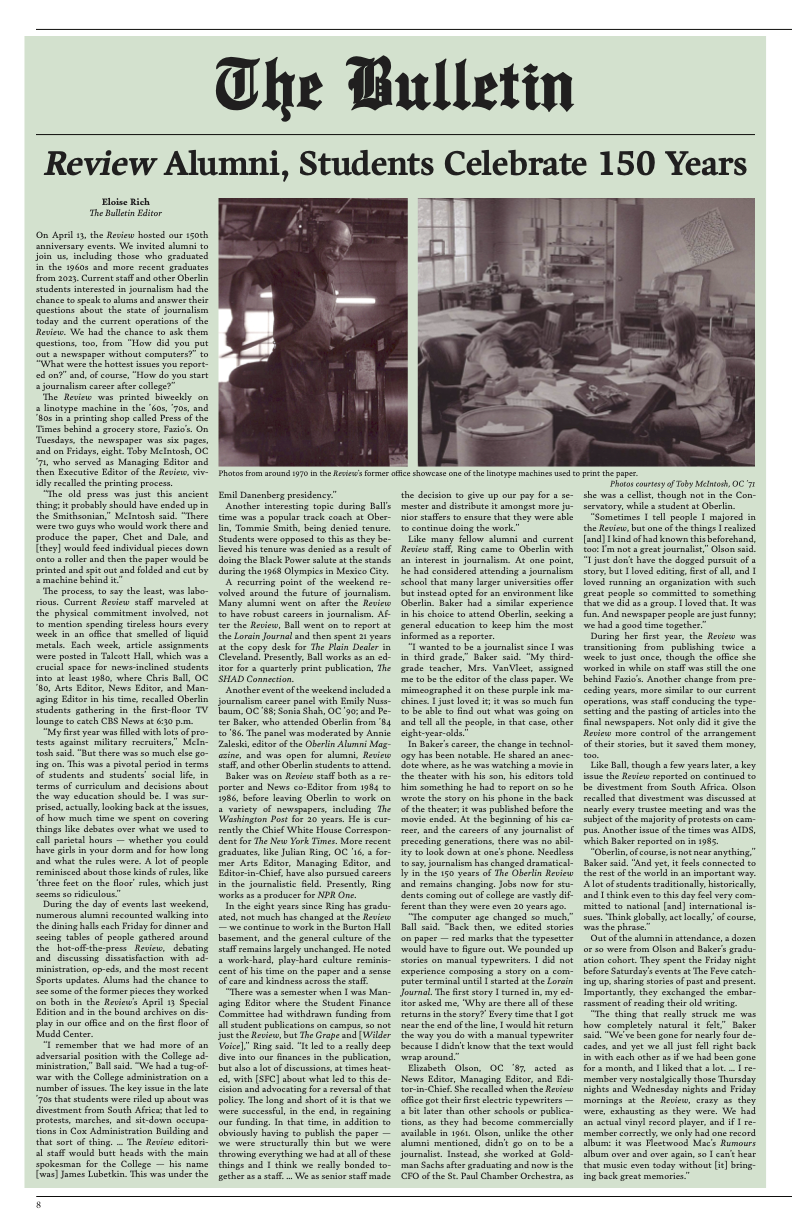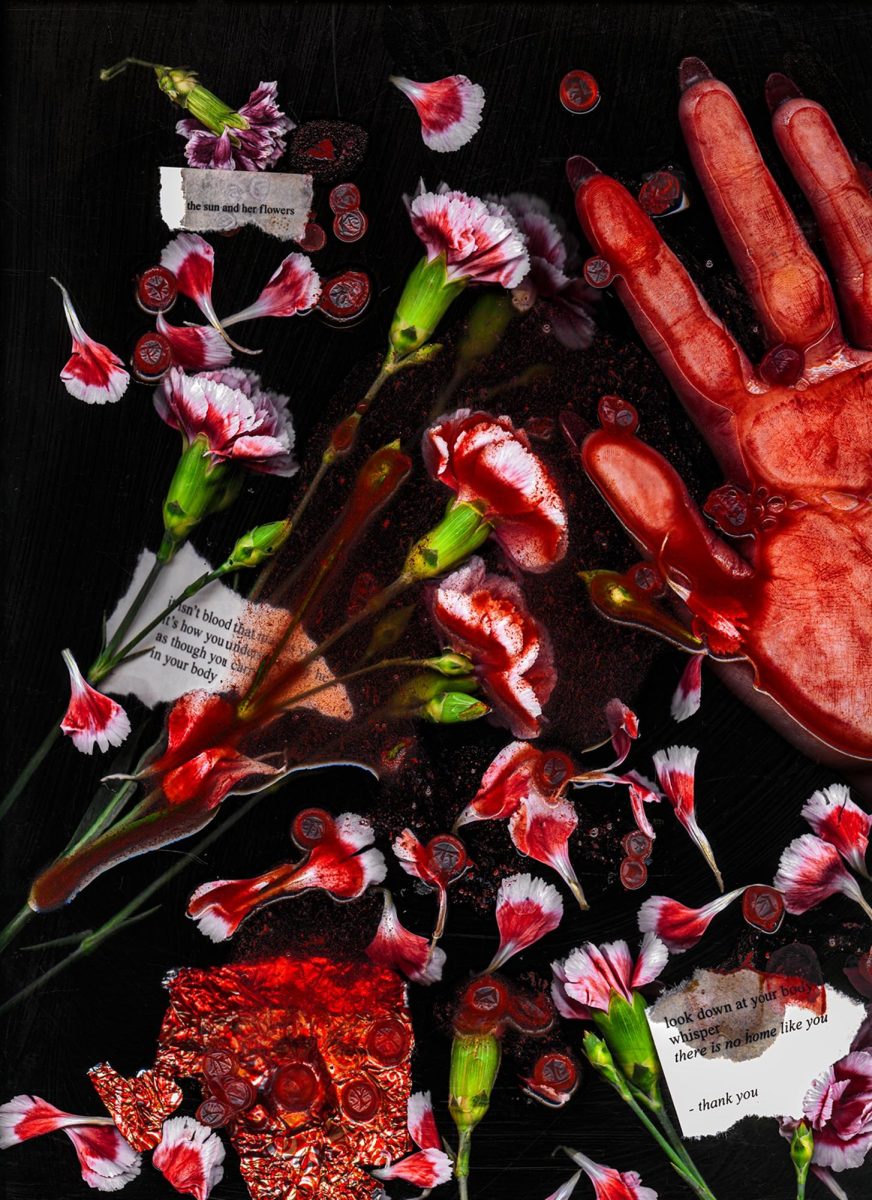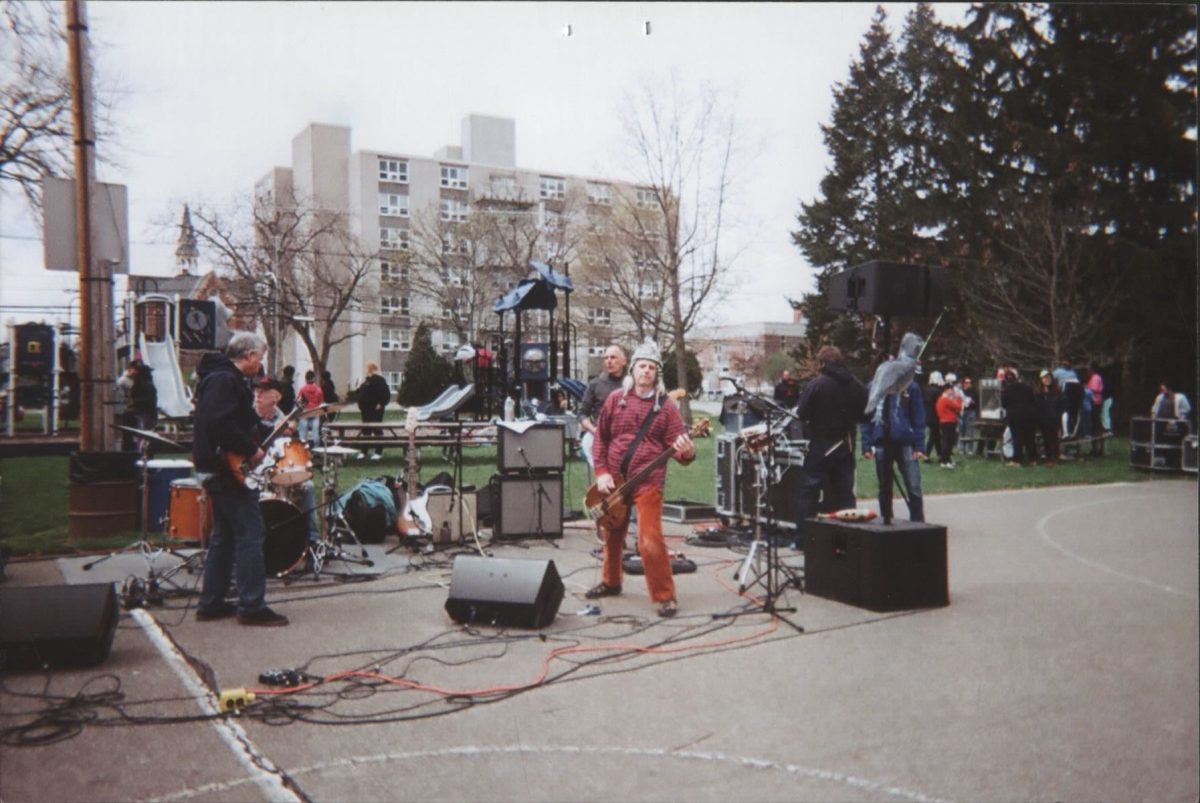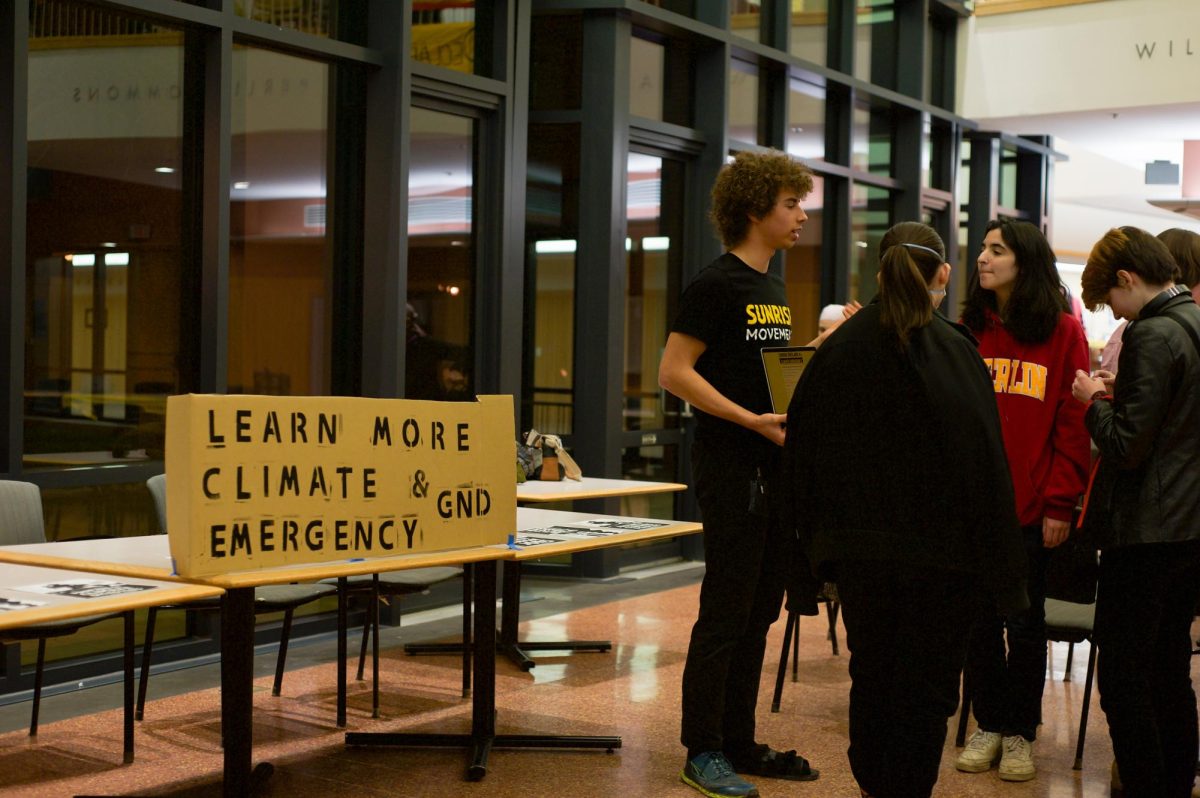On April 13, the Review hosted our 150th anniversary events. We invited alumni to join us, including those who graduated in the 1960s and more recent graduates from 2023. Current staff and other Oberlin students interested in journalism had the chance to speak to alums and answer their questions about the state of journalism today and the current operations of the Review. We had the chance to ask them questions, too, from “How did you put out a newspaper without computers?” to “What were the hottest issues you reported on?” and, of course, “How do you start a journalism career after college?”
The Review was printed biweekly on a linotype machine in the ’60s, ’70s, and ’80s in a printing shop called Press of the Times behind a grocery store, Fazio’s. On Tuesdays, the newspaper was six pages, and on Fridays, eight. Toby McIntosh, OC ’71, who served as Managing Editor and then Executive Editor of the Review, vividly recalled the printing process.
“The old press was just this ancient thing; it probably should have ended up in the Smithsonian,” McIntosh said. “There were two guys who would work there and produce the paper, Chet and Dale, and [they] would feed individual pieces down onto a roller and then the paper would be printed and spit out and folded and cut by a machine behind it.”
The process, to say the least, was laborious. Current Review staff marveled at the physical commitment involved, not to mention spending tireless hours every week in an office that smelled of liquid metals. Each week, article assignments were posted in Talcott Hall, which was a crucial space for news-inclined students into at least 1980, where Chris Ball, OC ’80, Arts Editor, News Editor, and Managing Editor in his time, recalled Oberlin students gathering in the first-floor TV lounge to catch CBS News at 6:30 p.m.
“My first year was filled with lots of protests against military recruiters,” McIntosh said. “But there was so much else going on. This was a pivotal period in terms of students and students’ social life, in terms of curriculum and decisions about the way education should be. I was surprised, actually, looking back at the issues, of how much time we spent on covering things like debates over what we used to call parietal hours — whether you could have girls in your dorm and for how long and what the rules were. A lot of people reminisced about those kinds of rules, like ‘three feet on the floor’ rules, which just seems so ridiculous.”
During the day of events last weekend, numerous alumni recounted walking into the dining halls each Friday for dinner and seeing tables of people gathered around the hot-off-the-press Review, debating and discussing dissatisfaction with administration, op-eds, and the most recent Sports updates. Alums had the chance to see some of the former pieces they worked on both in the Review’s April 13 Special Edition and in the bound archives on display in our office and on the first floor of Mudd Center.
“I remember that we had more of an adversarial position with the College administration,” Ball said. “We had a tug-of-war with the College administration on a number of issues. The key issue in the late ’70s that students were riled up about was divestment from South Africa; that led to protests, marches, and sit-down occupations in Cox Administration Building and that sort of thing. … The Review editorial staff would butt heads with the main spokesman for the College — his name [was] James Lubetkin. This was under the Emil Danenberg presidency.”
Another interesting topic during Ball’s time was a popular track coach at Oberlin, Tommie Smith, being denied tenure. Students were opposed to this as they believed his tenure was denied as a result of doing the Black Power salute at the stands during the 1968 Olympics in Mexico City.
A recurring point of the weekend revolved around the future of journalism. Many alumni went on after the Review to have robust careers in journalism. After the Review, Ball went on to report at the Lorain Journal and then spent 21 years at the copy desk for The Plain Dealer in Cleveland. Presently, Ball works as an editor for a quarterly print publication, The SHAD Connection.
Another event of the weekend included a journalism career panel with Emily Nussbaum, OC ’88; Sonia Shah, OC ’90; and Peter Baker, who attended Oberlin from ’84 to ’86. The panel was moderated by Annie Zaleski, editor of the Oberlin Alumni Magazine, and was open for alumni, Review staff, and other Oberlin students to attend.
Baker was on Review staff both as a reporter and News co-Editor from 1984 to 1986, before leaving Oberlin to work on a variety of newspapers, including The Washington Post for 20 years. He is currently the Chief White House Correspondent for The New York Times. More recent graduates, like Julian Ring, OC ’16, a former Arts Editor, Managing Editor, and Editor-in-Chief, have also pursued careers in the journalistic field. Presently, Ring works as a producer for NPR One.
In the eight years since Ring has graduated, not much has changed at the Review — we continue to work in the Burton Hall basement, and the general culture of the staff remains largely unchanged. He noted a work-hard, play-hard culture reminiscent of his time on the paper and a sense of care and kindness across the staff.
“There was a semester when I was Managing Editor where the Student Finance Committee had withdrawn funding from all student publications on campus, so not just the Review, but The Grape and [Wilder Voice],” Ring said. “It led to a really deep dive into our finances in the publication, but also a lot of discussions, at times heated, with [SFC] about what led to this decision and advocating for a reversal of that policy. The long and short of it is that we were successful, in the end, in regaining our funding. In that time, in addition to obviously having to publish the paper — we were structurally thin but we were throwing everything we had at all of these things and I think we really bonded together as a staff. … We as senior staff made the decision to give up our pay for a semester and distribute it amongst more junior staffers to ensure that they were able to continue doing the work.”
Like many fellow alumni and current Review staff, Ring came to Oberlin with an interest in journalism. At one point, he had considered attending a journalism school that many larger universities offer but instead opted for an environment like Oberlin. Baker had a similar experience in his choice to attend Oberlin, seeking a general education to keep him the most informed as a reporter.
“I wanted to be a journalist since I was in third grade,” Baker said. “My third-grade teacher, Mrs. VanVleet, assigned me to be the editor of the class paper. We mimeographed it on these purple ink machines. I just loved it; it was so much fun to be able to find out what was going on and tell all the people, in that case, other eight-year-olds.”
In Baker’s career, the change in technology has been notable. He shared an anecdote where, as he was watching a movie in the theater with his son, his editors told him something he had to report on so he wrote the story on his phone in the back of the theater; it was published before the movie ended. At the beginning of his career, and the careers of any journalist of preceding generations, there was no ability to look down at one’s phone. Needless to say, journalism has changed dramatically in the 150 years of The Oberlin Review and remains changing. Jobs now for students coming out of college are vastly different than they were even 20 years ago.
“The computer age changed so much,” Ball said. “Back then, we edited stories on paper — red marks that the typesetter would have to figure out. We pounded up stories on manual typewriters. I did not experience composing a story on a computer terminal until I started at the Lorain Journal. The first story I turned in, my editor asked me, ‘Why are there all of these returns in the story?’ Every time that I got near the end of the line, I would hit return the way you do with a manual typewriter because I didn’t know that the text would wrap around.”
Elizabeth Olson, OC ’87, acted as News Editor, Managing Editor, and Editor-in-Chief. She recalled when the Review office got their first electric typewriters — a bit later than other schools or publications, as they had become commercially available in 1961. Olson, unlike the other alumni mentioned, didn’t go on to be a journalist. Instead, she worked at Goldman Sachs after graduating and now is the CFO of the St. Paul Chamber Orchestra, as she was a cellist, though not in the Conservatory, while a student at Oberlin.
“Sometimes I tell people I majored in the Review, but one of the things I realized [and] I kind of had known this beforehand, too: I’m not a great journalist,” Olson said. “I just don’t have the dogged pursuit of a story, but I loved editing, first of all, and I loved running an organization with such great people so committed to something that we did as a group. I loved that. It was fun. And newspaper people are just funny; we had a good time together.”
During her first year, the Review was transitioning from publishing twice a week to just once, though the office she worked in while on staff was still the one behind Fazio’s. Another change from preceding years, more similar to our current operations, was staff conducing the typesetting and the pasting of articles into the final newspapers. Not only did it give the Review more control of the arrangement of their stories, but it saved them money, too.
Like Ball, though a few years later, a key issue the Review reported on continued to be divestment from South Africa. Olson recalled that divestment was discussed at nearly every trustee meeting and was the subject of the majority of protests on campus. Another issue of the times was AIDS, which Baker reported on in 1985.
“Oberlin, of course, is not near anything,” Baker said. “And yet, it feels connected to the rest of the world in an important way. A lot of students traditionally, historically, and I think even to this day feel very committed to national [and] international issues. ‘Think globally, act locally,’ of course, was the phrase.”
Out of the alumni in attendance, a dozen or so were from Olson and Baker’s graduation cohort. They spent the Friday night before Saturday’s events at The Feve catching up, sharing stories of past and present. Importantly, they exchanged the embarrassment of reading their old writing.
“The thing that really struck me was how completely natural it felt,” Baker said. “We’ve been gone for nearly four decades, and yet we all just fell right back in with each other as if we had been gone for a month, and I liked that a lot. … I remember very nostalgically those Thursday nights and Wednesday nights and Friday mornings at the Review, crazy as they were, exhausting as they were. We had an actual vinyl record player, and if I remember correctly, we only had one record album: it was Fleetwood Mac’s Rumours album over and over again, so I can’t hear that music even today without [it] bringing back great memories.”









